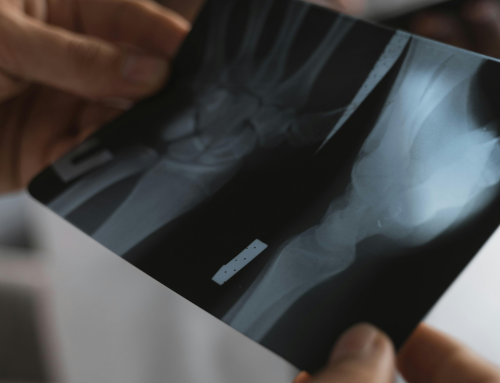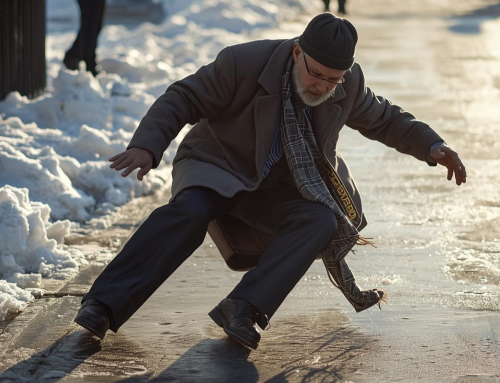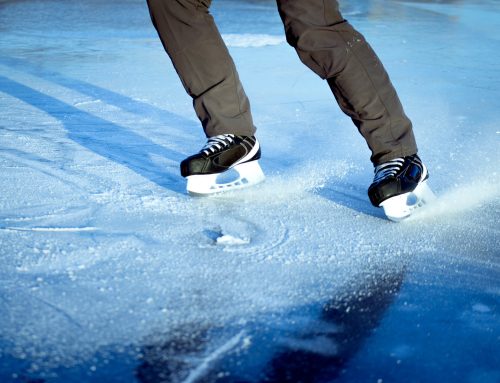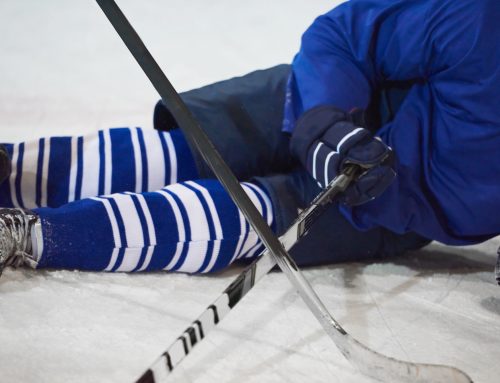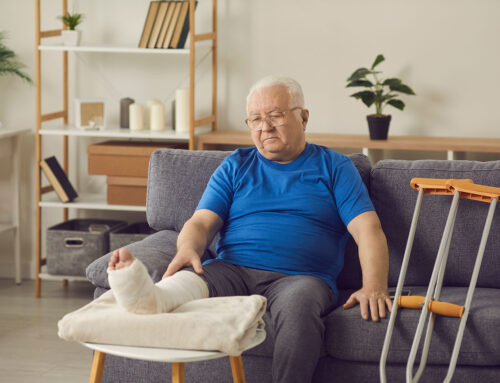As children, we are always tumbling around and falling down on all parts of our bodies. Many teenagers love playing sports and have pastimes like snowboarding or mountain biking, which are risky for injuries. When we are young, broken bones resulting from falls can heal quicker. But the older we get, the more deadly falls can be.

When seniors fall down, they often break or fracture a bone, and that fracture takes longer to heal. Falling is the number one reason seniors are hospitalized for an injury and sadly, 20 to 30 percent of all seniors in Canada fall every year. Thankfully there is Low-Intensity Pulsed Ultrasound (LIPUS) therapy that enables seniors to heal fractures faster at home and without doctor supervision.
Be careful where you step
There are now nearly seven million Canadians 65 years of age or older and more than 11,000 centenarians! Our population is getting older — seniors could represent between 23 and 25 percent of the total population in 2036. So increased attention on proper care for injuries sustained by seniors is important.
As our lives get longer, we also end up working for more years. The employment rate for seniors in Canada has increased since the 1980s. Employed seniors work primarily in consumer services. Elderly men frequently work in farming and women are more likely to work as a retail salesperson or clerk. Age increases the risk of injury on the job and the risk of fractures.
Most falls result in fractured bones, but seniors can also break bones while engaging in sports, such as skiing or playing tennis, or in more traumatic experiences, like a car accident or violent attack. Falls are the cause of 95 percent of all hip fractures in seniors, leading to death in 20 percent of cases. When seniors in Canada injure themselves from falling, the majority are to the shoulder or upper arm, followed by the knee or lower leg, then ankle or foot.
Research has found that seniors on average stay nine days longer in the hospital for falls, if they are hospitalized, than any other causes. This puts incredible strain on our healthcare systems. Around 50 percent of falls that result in hospitalization happen in the home, many are walking or doing household chores. Many falls also result from walking on snow or ice outdoors.
There are a number of conditions that put seniors more at risk of falling, including chronic and acute health concerns, balance issues, poor nutrition, sensory factors, and even social isolation.
Old bones don’t heal as quickly
Bones are made of living tissues that break down and rebuild, which is why minor fractures can heal mostly on their own. But as we age our bodies use up the calcium stored in our bones and bone cells are reabsorbed by the body faster than new cells can be made.
Bone mineral density decreases with age, making our bones become thinner and weaker. Bone density measures how much tissue is in your bones and indicates how strong they are. Our bones reach peak density around 30 years old and then begin to become less dense. Our bones are considered old much earlier than the rest of our bodies. By 40 years of age, your bones are already at a higher risk of breaking and not healing properly.
There are genetic differences to having dense bones, meaning people in the same family have similar bone composition. Generally, women have lower bone mineral density and this is why they are more susceptible to developing osteoporosis.
Our bodies heal more slowly with advanced age, and ageing is a risk factor for delayed fracture healing. The number of stem cells in our bone marrow declines as we age, which takes fractures longer to heal. Bone fracture healing requires adequate vascularization, which is the formation of blood vessels, of the tissue. Age hinders fracture healing by inhibiting vascularization at bone healing sites.
Many seniors also have co-morbidities, like diabetes or osteoporosis to name a few. Many are also on medications like NSAIDS and others that delay or inhibit the fracture healing process. If medications and vitamins are mixed or not taken as prescribed, they can weaken the body and cause negative impacts, such as dizziness, loss of appetite, and loss of bone density.
LIPUS lessens the effects of ageing on our bones
Ultrasound therapy can help speed up fracture healing times in older patients; elderly patients treated with Low-Intensity Pulsed Ultrasound (LIPUS) even have a heal rate comparable to young patients. In a study of more than 4000 patients with fresh fractures treated with LIPUS, older patients over 60 years old had a similar heal rate to the population as a whole. Patients with fractures who used LIPUS had a 95 percent heal rate, whereas the usual heal rate is around 93 percent. They recommended that elderly patients with risk factors that could cause a bone break not to heal be treated with LIPUS soon after the injury.
LIPUS therapy is easy for seniors to self-administer at home without a doctor’s supervision. The device is put to the skin over the fracture and with the press of a button, it sends a painless mechanical force through the tissue to stimulate the bone to heal. Most patients do not feel anything, whereas some may feel a slight tingling. The LIPUS devices work in just twenty minutes a day and are proven to heal non-union fractures by 86 percent.
Ways to better the health of your bones
Most of us are aware that calcium helps strengthen bones, but vitamin D is as important if not more. In Canada we get no vitamin D from the sun between November and March so it is important to have your vitamin D levels checked regularly and take supplements if and when you are low. Ensuring an all-around healthy and nutritious diet is key. Exercise is also important to build muscle and bone strength, which betters balance and flexibility and helps prevent falls.
Seniors should also ensure their home is free of tripping hazards, such as books on the ground, and get their eyes checked regularly. Stop smoking and drinking alcohol, especially when healing a fracture. It’s also important to check in regularly with your doctor about the medications being taken and possible negative interactions that could increase your risk of fractures.
Inline Medical Inc. has a subsidized rental program for LIPUS devices in Canada and ensures each patient receives a one-on-one phone consultation to train you on how to use the device. Even with ageing bones, you can get back on your feet sooner.

